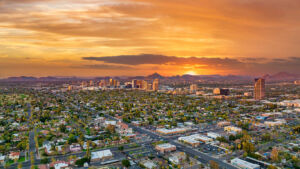The need to reconcile buyers’ preferences for more spacious homes with the need for more housing combined with growing building costs and less available land has created a compromise that’s leaving homeowners stranded for outdoor space and forced to deal with a smaller lot size when buying a home.
New single family homes are now built larger whereas lot sizes are getting smaller. In fact, the median home size is now over 2,260 square feet, up from 2,170 square feet in 2010. Meanwhile, the median lot size of a new home decreased by almost 18%, from 10,500 sq. ft. in 2010 to 8,700 sq. ft. in 2020, according to data from the U.S. Census, reducing the prospects for sizable backyards across the nation.
The white picket fence home with a manicured lawn at the front and a large backyard for family fun has been an essential component of the American dream for ages. But how much of the traditional aspiration towards expansive outdoor spaces is still achievable in the biggest US cities? And where do homeowners have the best chances to enjoy a nice backyard?
We looked at the 20 largest cities in the U.S. to discover the urban hotspots where residents enjoy the most space around their houses, a feature that has only gained in appreciation during the last 18 months as most of us spent more time at home than ever before. We’ve then tracked lot and home size evolution to see how new housing supply reshaped indoor and outdoor home spaces over the past 100 years.
Best cities for yards: lot size in Indianapolis almost 10 times larger than in Philadelphia
Indianapolis stands out as the city with the biggest home lots overall. Phoenix ranks No. 8 for lot size among the 20 biggest cities in the U.S., with an average lot size of 7,362 square feet. Southern cities generally rank better for lot sizes when compared to West and East Coast cities. The only coastal city to make it to the top for yard space is Jacksonville, FL. Austin, TX, Charlotte, NC, and Dallas, TX round out the top 5 cities with the biggest lots. All these urban hubs boast an overall median lot size of over 8,000 square feet.

At the other end of the spectrum, the smallest home lots among the country’s top 20 biggest cities are in Philadelphia, where the median plot size is around 1,100 square feet. Chicago, Washington, DC, San Francisco and NYC’s five boroughs– where both available land and prices are at a premium – all have median lot sizes under 2,800 square feet.
House lot shrinkage – an irreversible trend reshaping the homeownership dream
Minimum lot size regulations and zoning laws are material for hot debates in virtually all the country’s major urban hotspots – on the one hand, it’s natural to prefer living in nice neighborhoods with big yards and plenty of green space. On the other hand, keeping the minimum lot sizes up and dedicating a significant portion of a city’s available land exclusively to single family homes puts a lot of pressure on an already competitive housing market. The median home price at a national level currently stands at over $350,000, with 89% of the metros tracked by the National Association of Realtors seeing double-digit price increases year-over-year during the first quarter of 2021.
While there are indeed some variations, there is a general increase in lot space being built on – i.e., the percentage of a land plot occupied by the home, where the home size represents the total of the floor sizes – in all of the country’s biggest cities.
“The demand for housing in many markets is so much higher than the current supply that developers of new residential properties have to make the most of available land. This has led to an increase in what many would call single family condensed housing,” said Isaac Hiatt of Yardi Matrix, our sister division and a research firm focusing on multifamily, student housing, office, industrial and self storage properties across the United States.
Here’s how home lots evolved in the 20 largest US cities over the last 100 years.
Top 20 Biggest US Cities Ranked by Lot Size


The median lot size in Indianapolis – the city with the biggest home lots in the US – is almost 9,200 square feet, with the median home covering almost 1,500 square feet.
Even though Indy’s outdoor space is certainly large enough for entertaining, playing around and doing a bit of gardening, homes there are not exempt from lot size shrinkage. Lot usage increased in Indianapolis over the past century, from 19% in the 1920s to 27% over the past decade (2010 to 2020). The largest lots for new homes were in the 1960s, when the median lot size was over 14,000 square feet. Since then, lots gradually shrank with each decade, reaching a median size over the past decade of almost 8,000 square feet. The decade from 2010 to 2020 is also when the median size of newly built homes was largest – 2,100 square feet.

This trend toward smaller yards will most likely advance further, as Indianapolis was a seller’s market even pre-pandemic, and the coronavirus stirred things even more. The metro area’s median home price during the first quarter of 2021 jumped by almost 14% year-over-year, reaching $232,000, while the inventory is currently down by a whopping 50% year-over-year. Paired with construction costs that have been skyrocketing all over the country, the Indianapolis housing market is facing the exact combination of factors that leads to smaller lot sizes.
Searching for big lots in Jacksonville, FL, and Austin, TX? Shop around for homes built in the 60s and the 70s
In Jacksonville, median lot size is over 9,100 square feet, while median home size stands at around 1,800 square feet, meaning that the home covers about 20% of the lot. Decade-to-decade evolution during the past 100 years paints a more nuanced picture. The 1970s were Jacksonville’s best decade for large lots, with a median of over 11,000 square feet – while the homes built during that period had a median size of 1,800 square feet. However, in the last decade analyzed, 2010 to 2019, the median lot size fell to around 7,700 square feet, paired with a significantly higher median new home size of over 2,300 square feet. Thus, lot usage in Jacksonville for the past decade stands at around 30%, higher than during any of the previous decades.
Austin, with a median lot size of 8,600 square feet and a median home size of almost 1,900 square feet, is still a friendly city for people in search of roomy backyards. In Austin’s case, the median lot size from one decade to the other varied less than in other cities, from about 6,700 square feet in the 1920s to 7,400 square feet in the 2010s, with a peak of over 9,500 square feet in the 1960s. However, the median home size increased by almost 84% over the past 100 years, resulting in an increase in lot usage from 19% in the 1920s to 32% nowadays.



